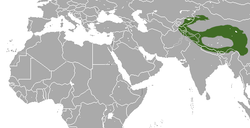Distribution and habitat
The large-eared pika is native to mountainous regions of Central Asia. Its range includes Afghanistan, Bhutan, India, Pakistan, Nepal, Kazakhstan, Kyrgyzstan and Tajikistan and the provinces of Gansu, Qinghai, Sichuan, Tibet, Xinjiang and Yunnan in China. Its minimum altitude is about 2,300 metres (7,500 ft) [1] and it has been recorded at altitudes of 6,130 metres (20,113 feet) in the Himalayas. The large-eared pika does not make a burrow but lives in crevices among the shattered rock and scree found in mountainous regions. [3]
Biology
The large-eared pika is territorial, an adult pair occupying an exclusive area. In different parts of their range they are found at densities varying between 6 and 18 individuals per hectare. They are prey species for various carnivorous mammals and birds of prey. [2]
The large-eared pika is an herbivore and is diurnal. It feeds on grasses and other vegetation, twigs, lichens and mosses. Some populations make "haypiles" of dried grasses in their burrows to help see them through the winter when fresh greenery is scarce. There are usually two litters a year, each with two to three young. The gestation period is approximately 30 days. The juveniles are mature by the next breeding season and the life expectancy of this species is about three years. [1]
This page is based on this
Wikipedia article Text is available under the
CC BY-SA 4.0 license; additional terms may apply.
Images, videos and audio are available under their respective licenses.


